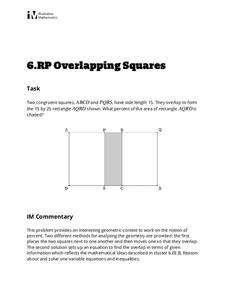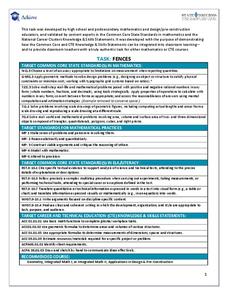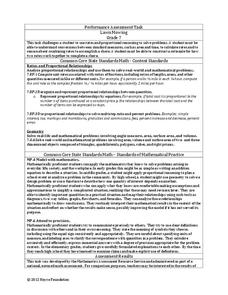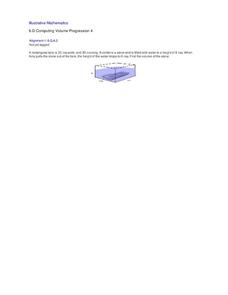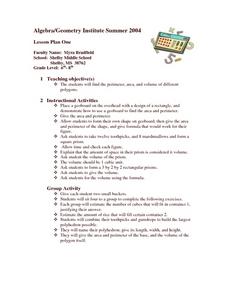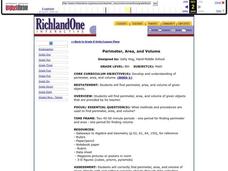Curated OER
Looking at Circumference
Students understand where the number for pi comes from. They understand and use the formula for circumference. Students measure the circles given out and the diameters of those circles and record the results on their worksheet.
American Statistical Association
Exploring Geometric Probabilities with Buffon’s Coin Problem
Scholars create and perform experiments attempting to answer Buffon's Coin problem. They discover the relationships between geometry and probability, empirical and theoretical probabilities, and area of a circle and square.
Illustrative Mathematics
Cari's Aquarium
The volume of a fish tank is a rather important measure when it comes to building an aquarium for different species of fish. In this problem, your kids look at how many different ways they can make a fish tank of a specific volume, then...
Illustrative Mathematics
Overlapping Squares
The objective of this activity is to find the percent of the area of a two squares overlapping. Mathematicians find the ratio of area for the part that overlaps to the rectangle formed. The final answer is a percent as a rate per 100....
EduGAINs
Making Savvy Consumer Choices
It's never too early to learn about grocery budgeting. Middle schoolers delve into the world of consumer math with a activity that focuses on both healthy choices and real-world math applications. Groups work together to form a grocery...
Achieve
Fences
Pupils design a fence for a backyard pool. Scholars develop a fence design based on given constraints, determine the amount of material they need, and calculate the cost of the project.
Noyce Foundation
Lawn Mowing
This is how long we mow the lawn together. The assessment requires the class to work with combining ratios and proportional reasoning. Pupils determine the unit rate of mowers and calculate the time required to mow a lawn if they work...
Noyce Foundation
Parallelogram
Parallelograms are pairs of triangles all the way around. Pupils measure to determine the area and perimeter of a parallelogram. They then find the area of the tirangles formed by drawing a diagonal of the parallelogram and compare their...
Noyce Foundation
Which is Bigger?
To take the longest path, go around—or was that go over? Class members measure scale drawings of a cylindrical vase to find the height and diameter. They calculate the actual height and circumference and determine which is larger.
Virginia Department of Education
Surface Area and Volume of a Cylinder
Surface area or volume? Pupils first review the difference between surface area and volume. They then use a two-dimensional net that helps them develop formulas for the surface area and volume of cylinders.
Annenberg Foundation
Geometry 3D Shapes: Platonic Solids
From polyhedrons to platonic solids, here is a lesson that will have your classes talking! As an introduction to platonic solids, scholars cut and fold nets to create the three-dimensional solids. They use an interactive component to...
Yummy Math
More Chocolate Candy?
Everyone knows that candy is the best part of any holiday—but which holiday's candy gives you the most bang for your buck? Analyze a chocolate heart, a chocolate bat, and a normal piece of chocolate to decide which piece of candy has the...
Curated OER
Volume of a Cube without a Picture
In this geometry worksheet, students draw and calculate the volume of a cube from the given side length measured in metric or customary. There are 8 questions with provided workspace.
Oleh Yudin
iCrosss
Did you know that a soccer ball is very similar to a truncated icosahedron? Both have 32 faces, but while a truncated icosahedron is made up solely of flat hexagons, a traditional soccer ball has 12 pentagons and 20 hexagons, each curved...
Curated OER
Net "Working"
Upper elementary and middle schoolers explore the properties of various polygons. They use video, resource links, and engage in hands-on activities in order to construct geometric nets. This fine plan should lead to increased...
Curated OER
Identifying Three-Dimensional Figures (2)
In this three dimensional figures review worksheet, students use their math skills to identify the 10 three dimensional figures pictured on the sheet.
Curated OER
Formulas for Volume and Surface Area
Students calculate the volume and surface area of each shape. For this geometry lesson, students use nets and other three dimensional polygons to create visuals of the volume of a shape. They define important vocabulary words relevant to...
Curated OER
A Cone and Its Net
Create and investigate nets for solid shapes with your class. They identify the different parts and faces of each polygon and solid then calculate the surface area and volume of cones. They use circle sectors of varying sizes to build...
Illustrative Mathematics
Computing Volume Progression 4
This resource was written for the younger math learner, but finding the volume of an irregular solid is also a problem for algebra and geometry students. Based on Archimedes’ Principle, one can calculate the volume of a stone by...
Curated OER
Lesson One: Perimeter, Area, Volume
Students explore perimeter, area and volume. Using geoboards, toothpicks, and marshmallows, students create specific shapes. They are directed to use formulas to find the volume, area, and perimeter of the created shapes. In groups,...
Curated OER
Density
Students find the mass, volume, and density of various objects. For this density measurement lesson, students observe how same-sized objects can have different masses, then use water displacement to find the density of each object and...
Curated OER
New York Testing Program
In this math review worksheet, students review for their 7th grade exam using a variety of worksheets on different topics. There are 35 problems plus some word problems in the worksheet booklet.
Curated OER
Perimeter, Area and Volume
Middle schoolers compute area. In this perimeter, area and volume lesson, students examine given objects and determine the perimeter, area, and volume of each.
Curated OER
Volume and Surface Area: Which Is More?
Students explore the volume and surface area of three dimensional figures. Through the use of video, students discover three dimensional shapes, their uses in real-life applications, and methods used to calculate their volume and surface...
Other popular searches
- Volume of Prisms
- Rectangular Prisms
- Volume of Rectangular Prisms
- Prisms and Pyramids
- Surface Area of Prisms
- Rectangular Prisms Nets
- Identify Prisms and Pyramids
- Triangular Prisms
- Volume of Prisms Cylinders
- Volume Prisms
- Volume Rectangular Prisms
- Volume of Triangular Prisms





